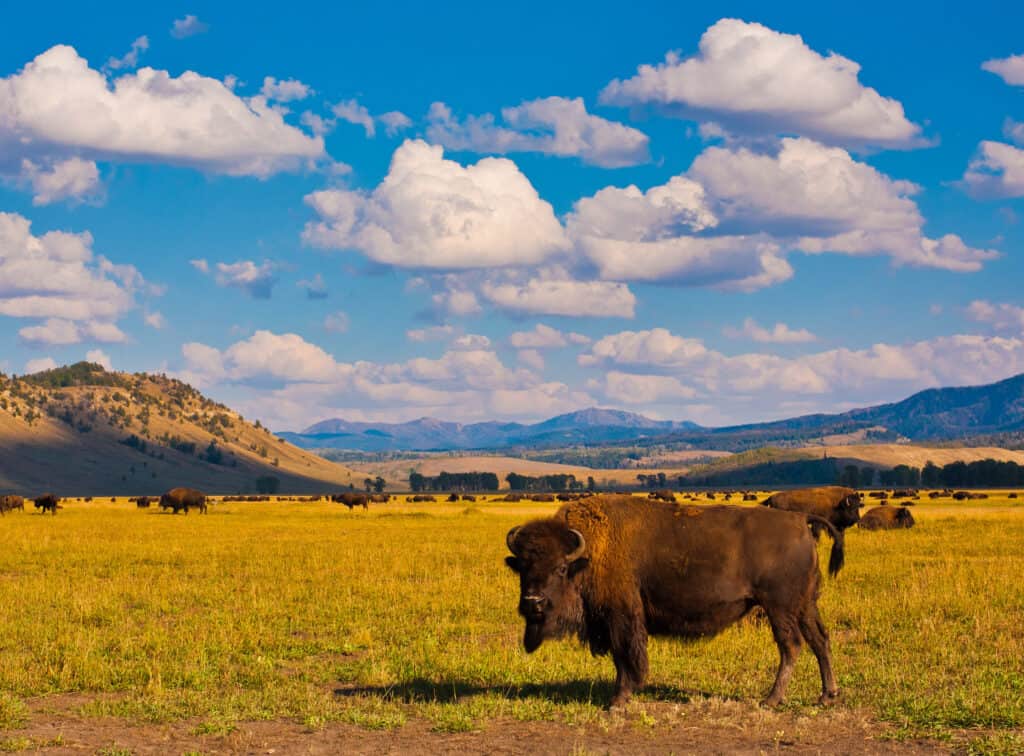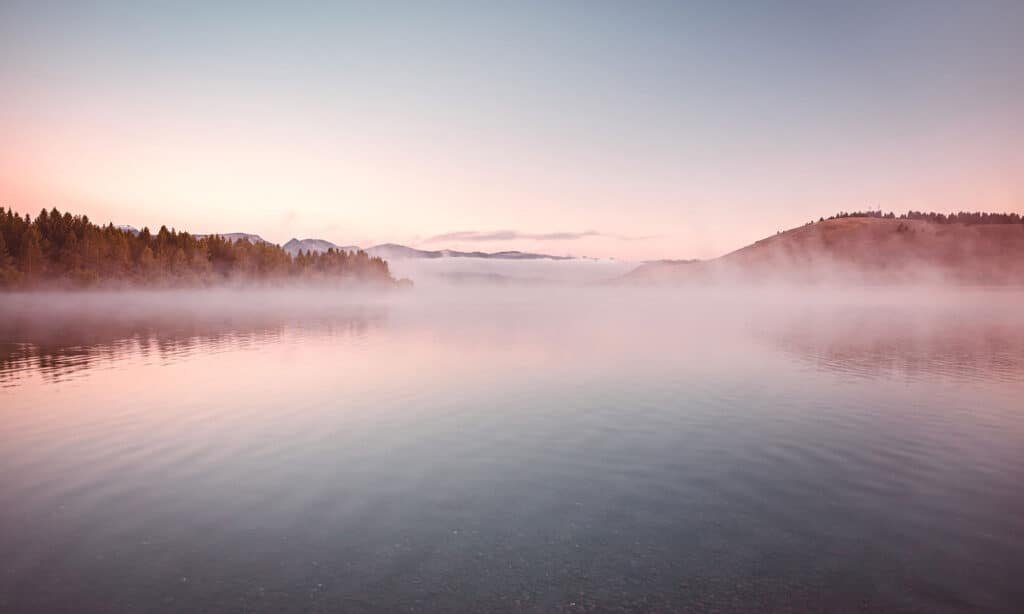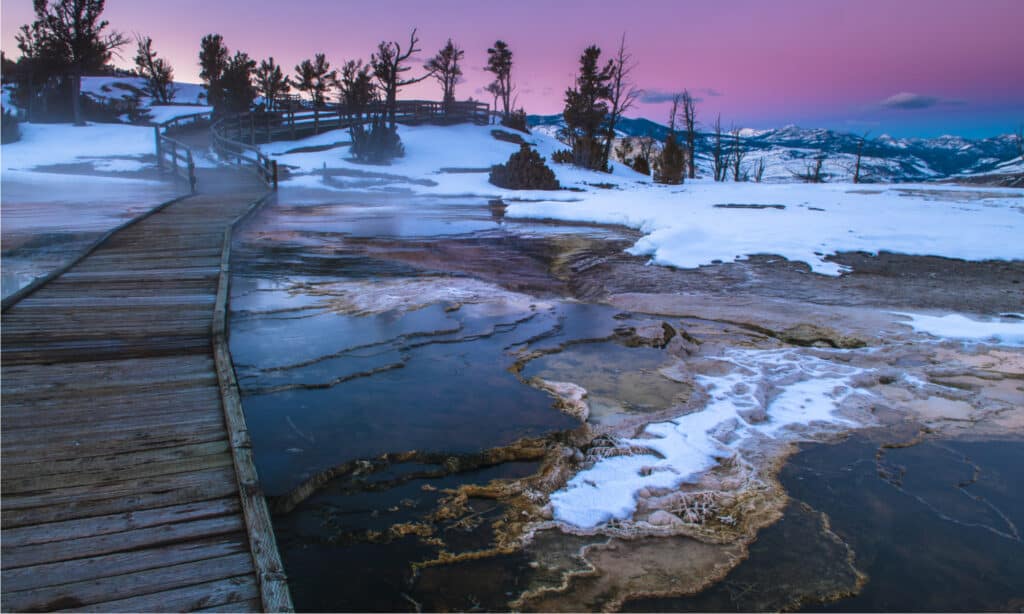You may not know this, but there is such a thing as the Yellowstone Caldera. Located within Yellowstone National Park, this vast and diverse landscape was formed millions of years ago by volcanic activity. But what is the Yellowstone Caldera, and can this supervolcano and volcanic area ever face another eruption, especially in our lifetime?
In this article, we will answer everything you need to know about the Yellowstone Caldera, including what the chances are of it erupting anytime soon. We will also discuss what the past eruptions were like, including the devastation left over from these supervolcano events. Let’s get started and learn all about Yellowstone now!

Yellowstone National Park is primarily built on a caldera, and one that formed after multiple volcanic events.
©Lillac/Shutterstock.com
| Yellowstone National Park | Caldera Facts |
|---|---|
| Size of Caldera | 30 miles by 45 miles |
| Past Eruptions | 3 large eruptions happened millions of years ago, dumping more than 6000 times the amount of debris that occurred during the Mt. St. Helens eruption! |
| Evidence for Future Eruptions | Obvious lava flow would need to occur, which has not happened in 70,000 years. Yellowstone volcanic experts are constantly monitoring the park and any potential hazards |
| Where to See Volcanic Evidence | Firehole Canyon, Lewis Falls, Washburn Hot Springs Overlook, Obsidian Cliff, Gibbon Falls, Tuff Cliff, Sheepeater Cliff |
Does Yellowstone National Park Have a Caldera?

The first supervolcano erupted over 2 million years ago in Yellowstone, and this formed the first of three calderas found within the boundaries of the park.
©Susanne Pommer/Shutterstock.com
Yes, Yellowstone National Park is primarily formed on a caldera, and one that formed after multiple volcanic events. Reaching roughly 30 miles by 45 miles, this portion of Yellowstone takes up a significant amount of the park itself. If you’ve ever been to Yellowstone National Park, you know this unique landscape is unlike any other, and it’s partially because of these volcanic events!
The first supervolcano erupted over 2 million years ago, and this formed the first of three calderas found within the boundaries of Yellowstone. This initial eruption was so powerful that it spewed forth enough volcanic ash and debris that it reached nearly 6,000 miles away. This explosion was far more powerful than the Mt. St. Helens eruption, on a scale that we likely can’t fathom nowadays.
The second caldera formed from a smaller volcanic eruption, just over 1 million years ago. This eruption wasn’t nearly as large as the first one, but it was still detrimental to the landscape. Finally, the third and final super eruption formed Yellowstone’s central caldera, which overlaps slightly with the first caldera. This eruption contained nearly 240 cubic miles of debris, and it occurred nearly 650,000 years ago.
Where is the Yellowstone Caldera Located?

The third and final super eruption formed Yellowstone’s central caldera, which overlaps slightly with the first caldera.
©Lorcel/Shutterstock.com
The Yellowstone Caldera is primarily located in the center of the park, with other caldera locations resting along the western border. The third and final large volcanic eruption formed the central Yellowstone Caldera, and you can easily find it on many different Yellowstone National Park maps.
While the other two calderas form a much larger portion of the park, the third caldera is considered the Yellowstone Caldera, given its centralized location within the borders of the park. It is also extremely visible from many different locations in Yellowstone, though it may not look like what you are expecting. You are more likely to see volcanic features like lava rocks rather than a mountainous structure!
Will the Yellowstone Caldera Erupt Again?

Many Yellowstone volcanic and seismic experts mention that an eruption is unlikely to occur anytime during the next couple hundred years, though there’s no guarantee.
©iStock.com/juliannafunk
Scientists say that yes, the Yellowstone Caldera will indeed erupt again. However, the chances of it happening during our lifetime is extremely unlikely. Many Yellowstone volcanic and seismic experts mention that an eruption is unlikely to occur anytime during the next couple hundred years, though there’s no guarantee.
The most important thing to mention is the fact that any volcanic activity is easy to monitor and track. A volcano does not erupt unexpectedly, not with so many experts keeping an eye on things in Yellowstone National Park. In fact, Yellowstone employs a number of scientists and experts to keep an eye on nearly 30 seismic activity stations, a dozen steam gauge stations, and countless GPS tracking locations.
Where Can I See the Yellowstone Caldera and Volcanic Flows?

A volcano does not erupt unexpectedly, not with so many experts keeping an eye on things in Yellowstone National Park.
©Kris Wiktor/Shutterstock.com
There are a number of unique volcanic features to see in Yellowstone National Park, all found in the Yellowstone Caldera region of the park. Some of these features include:
- Basalt
- Ash flow and deposits
- Lava flow
- Tuff (volcanic ash rocks)
- Rhyolite
- Caldera rims, basins, and other features
There are a number of different locations for you to view these features. They are primarily all found in the Yellowstone Caldera region of the park, which occupies a significant portion of Yellowstone. Here’s where you should visit, and what you’re likely to see there!
- Firehole Canyon- lava flows along the Firehole River
- Lewis Falls- close enough to the Caldera rim for a good look
- Washburn Hot Springs Overlook- a fantastic view of the Caldera and a resurgent dome
- Obsidian Cliff- lava flows are possible here
- Gibbon Falls- Check out the Caldera rim from this spot
- Tuff Cliff- unique ash flows and rock formations
- Sheepeater Cliff- beautiful columns of basalt form unique structures
There’s so much more than these locations throughout Yellowstone National Park. The entire area has been formed by volcanic activity, so it’s no wonder that there’s plenty to do should you be planning a trip to Yellowstone!
The photo featured at the top of this post is © Lillac/Shutterstock.com
Thank you for reading! Have some feedback for us? Contact the AZ Animals editorial team.






